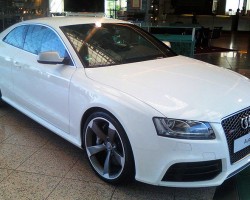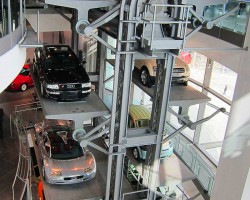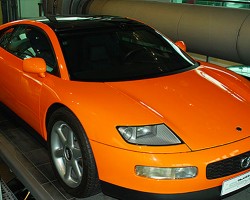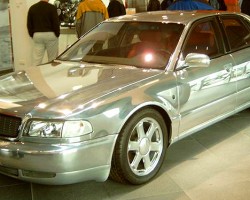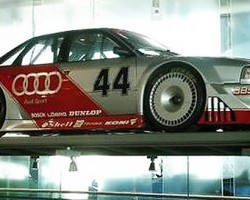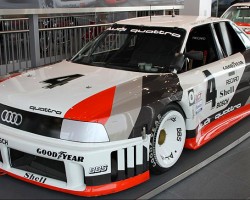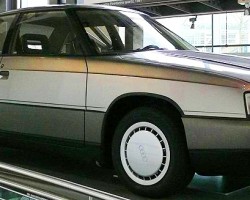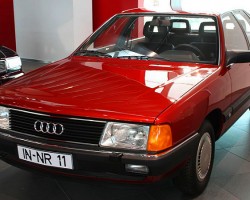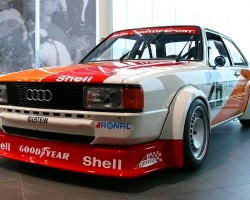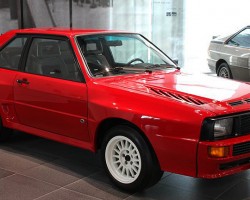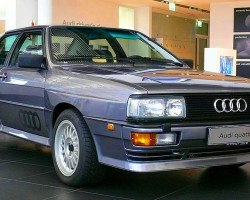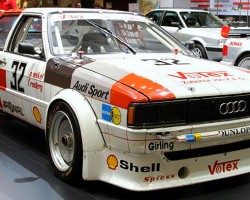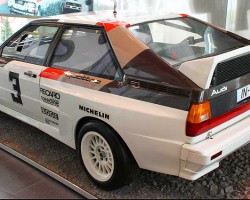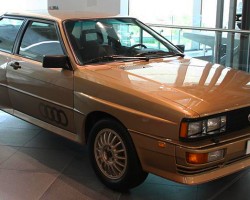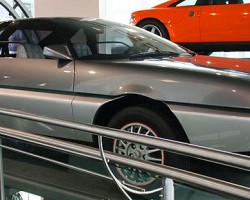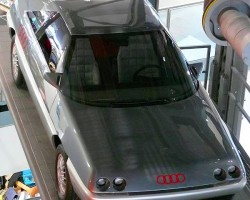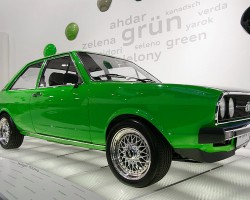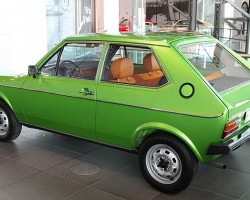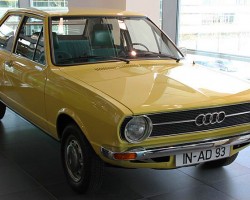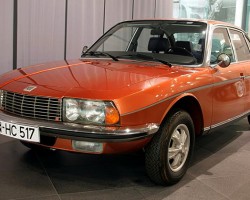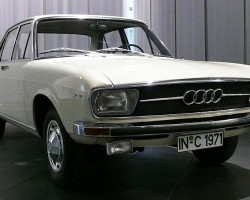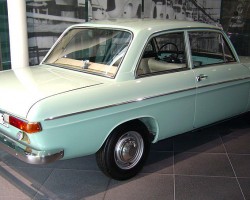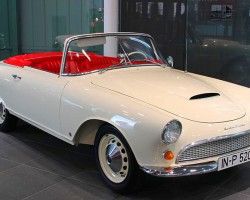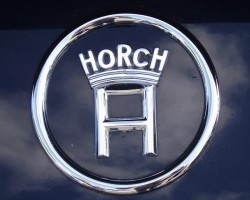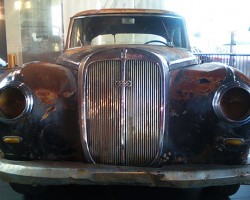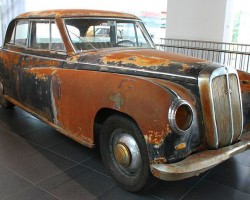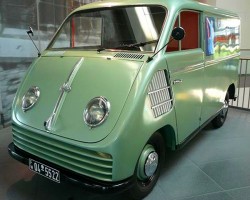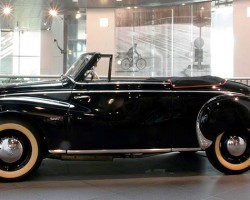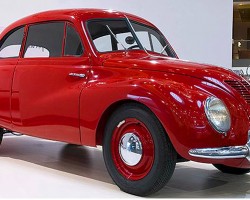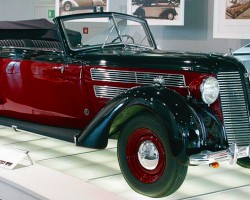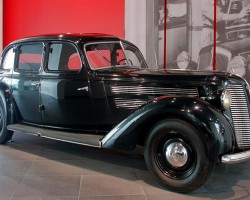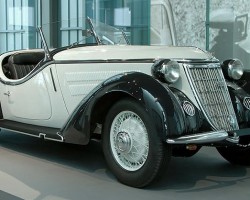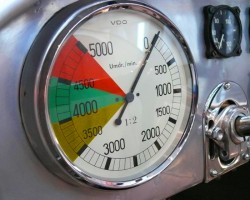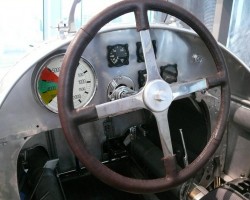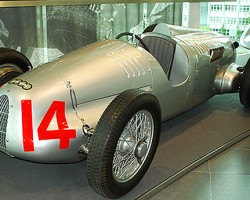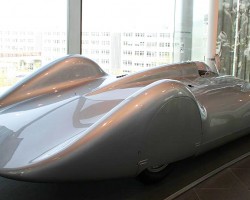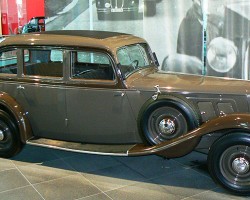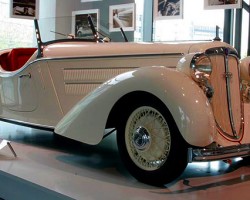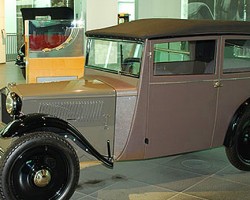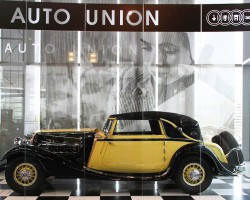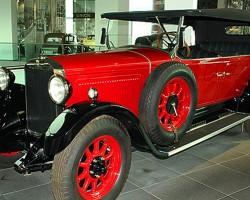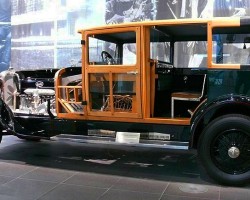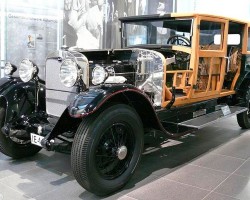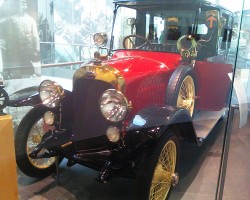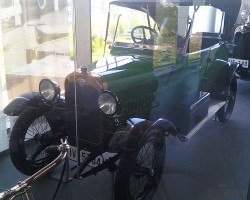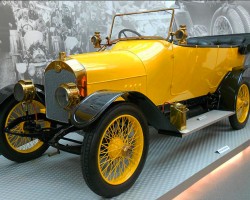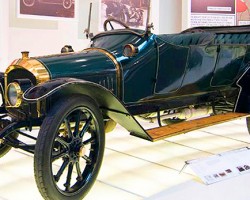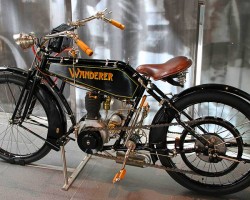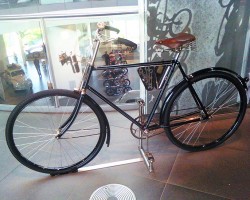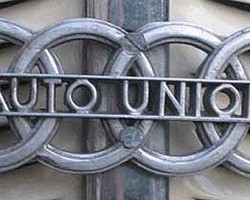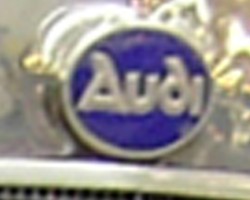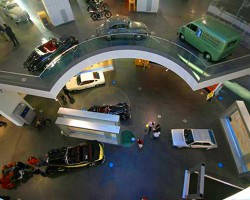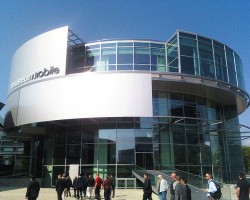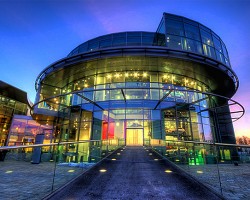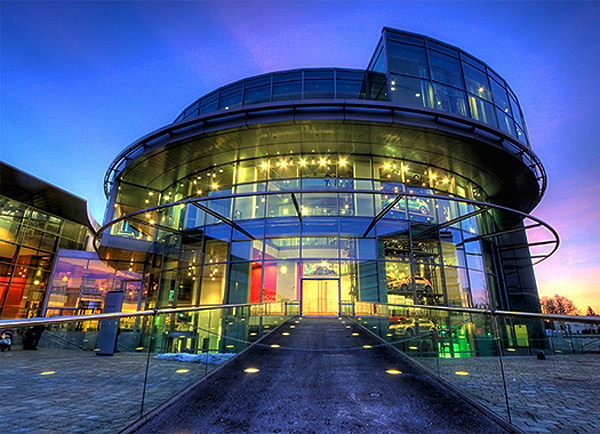
The Audi Museum located on the grounds of company headquarters in Ingolstadt is a must see for any automotive history buffs visiting southern Germany. (Photo credit: D. Mueller)
Audi fanatics, do you know what year the marque was founded? Where the name “Audi” comes from and how it was picked? What major German automaker owned it before selling it to Volkswagen? What the first Audi logo used was? What iconic 1950s American car model Audi used as inspiration to style one of their own models after?
(See slideshow at end of article for pictures inside the museum. We recently had the opportunity to visit the Museum, and answer all these questions with images further below.)
A tour of the Audi Museum at company headquarters in Ingolstadt, Germany will give you a well-rounded education about the brand’s history, philosophy, mergers, failures, successes, technology and future plans.
Opened in December 2000, the 265,000 square-foot MUSEUM MOBILE features four levels which contain close to 60 cars and over 30 motorcycles spanning the timelines of the Audi brand itself, and sister brands DKW, Wanderer, Horch, and NSU that were once merged together.
Because of the museum’s all-glass exterior, rotating shields (visible in the picture at top left) literally follow the path of the sun, moving around the exterior of the building to block direct sunlight rays which can damage exhibits.
Once entering, one takes the elevator (or “time machine”) up to the top level which begins the tour in 1899. The two levels of the permanent exhibition, 1899 to 1945 and 1946 to 2000, are each further divided into seven sections.
A Brief History of the Audi marque:
In 1899, August Horch began as a motor vehicle producer by establishing Horch Auto-Werke in Zwickau, Germany. Because of disputes with his own board of directors, Horch was forced out in 1909. Eager to start another automobile business immediately, lawyers informed him the Horch name was now trademarked to his old company, and was not to be used by him in any new ventures. Since the surname Horch happens to mean “Hark” or “hear” in German, his young son studying Latin convinced his father to use the Latin translation of the word hear/listen, which is “Audi”.
A year later in 1910, the first cars bearing the Audi name were produced, simply called Type A, and Type B. This model naming tradition continued further up through the alphabet.
1932 saw the merging of Audi with Horch Auto-Werke (Mr. Horch’s original company), DKW, and Wanderer – all of which were German automobile manufacturers with similar roots dating back to the late 19th century. The new merged company was named “Auto Union” and the four-ringed logo was created to signify the four brands. The new logo adorned the front of all models produced by these four makes, and was not yet specific to Audi during this time (similar to the General Motors “GM” logo).
Reflecting poorer economic conditions of the 1930s, Auto Union concentrated on more affordable cars during this decade. By 1938, its DKW brand most associated with small, cheap wheels accounted for 18% of the German market, while Audi and Horch brands that had established themselves as luxury car producers suffered greatly. At the end of the 1930s, Audi held barely a fraction of a percent of the market share.
Similar to the United States, German heavy manufacturing plants including automakers were fully retooled for World War II military production around 1941, grinding new car production to a halt. German factories suffered heavy bombing during the war, and ones that survived were overrun by the Soviet army and dismantled in 1945 as part of war reparations. Stripped of all production capacity, Auto Union AG ceased to exist until its rebirth in 1949.
Remains of the least decimated Zwickau plant were rebuilt, and “Automobilwerke Zwickau” (AWZ) was initially formed in 1949 as production of pre-war DKW models began again – temporarily badged the IFA F8 and F9. Later on in 1949, AWZ was fully reincorporated as the new Auto Union, now headquartered in Ingolstadt where it remains today.
Continuing where the company had left off before World War II, the first post-war cars produced were badged DKWs and sold with the lowest possible price point. The Wanderer brand was not resurrected, and although Audi and Horch brands were alive again, they were barely breathing (Horch AutoWerke did not survive to see the end of the 1950s).
In 1958, Daimler-Benz (Mercedes) bought 87% of the struggling Auto Union, increasing ownership to 100% a year later. It is fair to say that Audi would not be the company it is today had it not been for Mercedes-Benz heavily investing in new Auto Union assembly plants during the early 1960s – the largest one being located in Ingolstadt at AutoUnion corporate headquarters.
By 1964, Auto Union was still losing money badly and parent company Mercedes came to believe their investment in new plants and upcoming new models would never see a return. Eager to cut losses, Auto Union was fully sold to Volkswagen over a two-year period from 1964 to 1966. At this time Volkswagen did not have advanced engine or front-wheel-drive technology that Auto Union was gaining, and was extremely interested in obtaining it for its own models.
Volkswagen quickly dumped the DKW brand because of it’s predominantly crude 2-stroke engine image (lawnmower engines are 2-stroke for example), and focused on fully resurrecting Auto Union’s remaining Audi brand with technology developed under Mercedes ownership. What was to be the DKW “F103” was simply sold as the “Audi” for 1966…with the familiar four-ring Auto Union logo on the front.
Volkswagen also purchased German brand NSU and merged it into Auto Union in 1969 for their engineering expertise gained producing rotary-powered engines in the 1960s. Because they weren’t predominently interested in maintaing the NSU brand itself, it was discontinued in 1977. Audi-NSU-Auto Union was now shortened to Audi-Auto Union (The last NSU model, a rotary-powered Ro-80, resides in the museum).
The Audi brand is introduced in the United States for 1970
The small Audi introduced for 1966 and the larger “100” models introduced for 1968 sold so well in Germany, Volkswagen brought them to the United States as the “Super 90” and the “100LS” for the 1970 model year. Both were available in 2-door or 4-door configuration and featured a 1.8-liter 4 cylinder engine with front-wheel-drive.
The Super 90 was replaced by the 1973-79 Fox, and the 100LS was later replaced by the 1978-83 “5000”. A new four-cylinder engine with a modern overhead camshaft design and fuel injection was introduced in both models for 1975.
Quattro full time 4-wheel-drive
During the late 1970s, Audi engineers began testing cars equipped with full time 4-wheel-drive systems. They believed its performance and handling benefits driving in rain, racing, and offroad rallye applications were so superior that they sold the idea to top management after test drives, and the Quattro badge was born. First equipped on the new-for-1981 “Coupe” sport hatch model, rallye versions saw immediate racing victories.
While Quattro was introduced on 1981 coupe models in Germany, it was delayed on U.S. Coupes until the ’83 model year. And for 1984, the redesigned 5000 model and the existing 4000 model (1980-87) received the optional Quattro system as well. It has become a hallmark of every Audi model introduced since, and currently over 90% of models in the Northern half of the United States are ordered with the option. The Audi-Auto Union offical name was now shortened to just Audi in 1985.
Into its second century today, the Audi luxury brand typically sells over 1 million vehicles per year worldwide and shows no signs of slowing its achievements. With a variety of 8, 10, and 12-cylinder engined models, the brand commands more of a premium than it ever has. Eindrucksvolle Arbeit! (Impressive work).
CLICK ON ANY OF THE PICTURES BELOW TO EXPAND TO FULL SIZE. USE ARROWS UNDERNEATH PICTURES TO SCROLL BACKWARD OR FORWARD
- The RS5, introduced for the 2010 model year in Europe is a high-powered ultra performance version of the S5 coupe. (Photo credit: Sean Connor)
- A rotating platform in the museum several stories high displays concept models displayed over the years at worldwide auto shows. (Photo credit: Sean Connor)
- The 1991 Audi Quattro Spyder concept car. (Photo credit: Sean Connor)
- This mid-1990s concept car was created to showcase the all-aluminum frame of the first A8 model introduced for the 1997 model year. (Photo credit: Sean Connor )
- A 1993 Audi 80 Quattro IMSA racecar. (Photo credit: Sean Connor)
- A 1988 Audi 90 IMSA GTO race car. (Photo credit: Sean Connor)
- Shown on the vertical rotating lift is an early 1984 styling mockup of the 80 / 90 models that debuted in the United States for 1988. (Photo credit: Sean Connor)
- Introduced as the 1984 5000 in the United States, this model first featured the aerodynamic styling later adopted on all Audis. For the 1989 model year, the model name was changed to 100 (a return to 1970 roots). The Quattro system was next introduced on this car for its first model year 1984. (Photo credit: Sean Connor)
- (1980-87 Audi 4000). Like the above coupe Quattro, this mid-’80s 4000 coupe was equipped for rallye racing, also with full-time Quattro and a 408 horsepower 5-cylinder engine. Quattro was made available on U.S. production versions of this model for 1984.
- This 1984 Coupe Quattro Sport was built on a shortened wheelbase to reduce weight, and a high-pressure version of the five-cylinder turbo engine produced 408 horsepower. Many racing victories followed. (photo credit: Sean Connor)
- The Coupe Quattro was the first Audi to feature the Quattro full time all-wheel-drive system. However the Coupe Quattro was not imported to the United States until the 1983 model year with a turbocharged version of the five-cylinder standard (130 horsepower). Shown is a European market version. (Photo credit: Sean Connor)
- Another early Coupe Quattro version equipped for racing. (Photo credit: Sean Connor)
- Before going into production several years later, the Quattro version of the coupe was put to the test during the 1981 rallye season, and emerged with a number of victories that year. (Photo credit: Sean Connor)
- Introduced for the 1981 model year, the production Coupe was powered by a five-cylinder engine producing 100 horsepower. Photo credit: Sean Connor
- An alternate view of the “Quartz” concept car. (Photo credit: Sean Connor)
- Italian design studio Pininfarina created this “Quartz” concept car for Audi in 1981 as a look at the company’s future styling. (Photo credit: Sean Connor)
- The Fox GTI sport package was offered for 1978 and 1979, and featured tachometer rallye gauge package, sport steering wheel, Recaro seats, blacked out trim, and more. (BBS wheels shown are not original equipment).
- The 1975-78 Audi 50 model was created to compete in the supermini size category in Europe made popular by the original Mini Cooper. Sister to the Volkswagen Polo (sized smaller than the 1975-84 Rabbit), these were powered by four cylinder engines ranging in size from .9 liters to 1.3 liters. The 50 was never imported to the U.S. (Photo credit: Sean Connor)
- (1973-79 Audi Fox) The Fox / 80 may be the earliest association with Audi that Americans over the age of 40 most have. Powered by a 1.5-liter four cylinder producing 91 horsepower, the Fox was available initially in two- and four-door sedan configuration, followed by a wagon offering for 1975. After 1973 all engines were fuel injected. GTI two-door sport versions were offered from 1978-79. Quad headlamps replaced single ones for 1977. (Photo credit: S. Connor )
- (1968-77 NSU Ro-80). NSU was a German brand that, like many others, began with motorcycle production in the late 1890s. In the 1960s, NSU pioneered development of the Wankel rotary engine which eschewed traditional pistons. NSU merged with Auto Union in 1969, and this model was sold in the U.S. as late as 1977. A twin-rotor engine of 129 horsepower drove the front wheels. (Photo credit: Sean Connor)
- The 100 marked the return of the Audi brand producing cars of a more upscale nature. Powered by a 92-horsepower four cylinder engine driving the front wheels, a 4-speed manual was standard and a 3-speed automatic was optional. Front disc brakes were standard. When Volkswagen brought Audi to the United States for 1970, this model was known as the 100LS. (Photo credit: Sean Connor)
- Known as the “72” in Germany from 1965-69, this model was sold in the U.S. from 1970-72 in two-door and four-door versions, the Super 90 was based on a stillborn DKW model developed before Daimler-Benz sold Auto Union to Volkswagen. This was replaced by the 1973 Audi Fox. Credit: S. Connor
- Heavily inspired by the 1955-57 Ford Thunderbird two-seat roadster, DKW introduced this two-seater initially as a coupe only for the 1958-61 model years, joined by a convertible version from 1962-65. To give the car a more upscale image than DKW was known for, it was simply badged the Auto Union 1000Sp in later years. All were powered by two stroke, four-cylinder engines driving the front wheels. (Photo credit: S. Connor )
- The Horch Motor Cars brand logo. (Photo credit: Sean Connor)
- A front view of the 1953 Horch. (Photo credit: Sean Connor)
- The last Horch vehicle produced was this 1953 sedan, built for the CEO of Auto Union at the time. Recently recovered from Texas after sitting in a field for years, (A U.S. serviceman stationed in Germany purchased it and shipped it home originally), the Audi museum opted to keep it in unrestored survivor condition. (Photo credit: Sean Connor)
- Being the first Auto Union model to see production after WWII, the Schnellaster (Rapid Transporter) van was way ahead of its time. With a transversely mounted front engine, front-wheel-drive, short sloping hood, a flat floor with flexible seating configurations, this van was truly the precursor to the modern compact minivan. However it was anything but rapid when equipped with either a two-stroke 2 cylinder engine of 20 horsepower, or a 3-cylinder engine of 32 horses from 1955 on. Production ran from 1949-62. (Photo credit: Sean Connor)
- Based on the F9 prototype of 1941 (see previous picture), the F89 convertible was produced from 1950-54 and featured a front engine and front-wheel-drive. (Photo credit: Sean Connor)
- Inspired by aerodynamic design trends of the 1930s, the DKW F9 prototype was targeted toward potential Volkswagen Beetle customers in Germany. Unlike the Beetle, it featured an engine in the front (a 3-cylinder two stroke engine) along with front-wheel-drive, and had an extremely low coefficient of drag for its time (.42 Cd). Originally targeted for production as a 1941 model, World War II intervened and the F9 did not actually see production until 1949-56. (Photo credit: Sean Connor)
- A convertible version of the 920. (Photo credit: Sean Connor)
- The Audi 920 sedan was produced from 1938-1940 and featured a 75 horsepower inline six-cylinder engine. Unlike smaller Audis of the 1930s, this model featured traditional rear-wheel-drive. (Photo credit: Sean Connor)
- The Wanderer W25K two-seat roadster is a great example of the sporty, high quality image the brand enjoyed. (Photo credit: Sean Connor)
- A closer view of the 1938 Type C racer’s instrumentation. (Photo credit: Sean Connor)
- The driver’s cockpit of the Auto Union Type C racecar shown in the previous picture. (Photo credit: Sean Connor)
- Auto Union began working on Grand Prix race cars in 1933, which saw their first racing season for 1934. Initial TYPE A and TYPE B models featured V12 engines, and garnished many racing victories. TYPE Cs featured a V16 engine, while final TYPE Ds used mostly V12s (and were equipped with dual rear wheels). This model shown is a 1938 TYPE D built with an earlier C V-16 engine. (Photo credit: Sean Connor)
- A reproduction of the The Type C “Streamliner” aero racecar of 1937, which represented the most powerful development stage of the Auto Union 16-cylinder racing car. The Streamliner celebrated its debut at the 1937 Avus Race.
- This 1934 Audi FRONT sedan was a short-lived series of front-wheel-drive models badged as Audis, using technology borrowed from DKW after the 1932 Auto Union merger. (Photo credit: Sean Connor)
- Initially presented early in 1933, the Audi Front 220 was Europe’s first car to combine front-wheel drive with a 6-cylinder engine. The 2.0-liter engine was replaced by a 2.25-liter one in 1935, and became known as the “225”. The larger-engined car introduced in 1935 continued to be offered until 1939. The 2.0-litre engine was shared with Auto Union’s Wanderer W22 introduced that same year. (Photo credit: Sean Connor)
- The DKW brand began by building motorcycles in 1919, and by the 1930s was the largest motorcycle manufacturer in the world. DKW began building cars in 1928, and in 1931 was a pioneer in front-wheel-drive technology. This 1932 F1 model shown was the first of many offerings from the marque until it was closed by VW in 1965. (Photo credit: Sean Connor)
- The Horch 670 was produced from 1931 to 1934, and featured a 6.0-liter V-12 engine producing 120 horsepower. (Photo credit: Sean Connor)
- Horch AutoWerke founded by August Horch in 1899 continued on even after Mr. Horch was ousted from the company. The Horch 8 of the late 1920s was an example of the high-end luxury cars the brand was known for. The Horch brand was later united with Audi in 1932 when Auto Union was formed. (Photo credit: Sean Connor)
- The Type M was the first Audi equipped with brakes at all four wheels. The expensive-to-produce Type M brought Audi to very close bankruptcy. 228 copies were produced plus two prototypes. (Photo credit: Sean Connor)
- A cutaway display of an Audi Type M which was produced from 1925-28, and featured an inline 6-cylinder in-line engine of 4.7 liters of displacement (69 horsepower). Photo credit: Sean Connor
- The Audi Type G, produced from 1914 – 1919. (Photo credit: Sean Connor)
- The Audi Type C of 1919. Several years later, Audi was the first German automaker to introduce a left-hand drive version of this car. (Photo credit: Sean Connor)
- Improving on the Type A above, the Audi Type B was also produced as a 1910 model, with horsepower bumped up to 28. (Photo credit: Sean Connor)
- This 1910 Type A was the first production model under the Audi nameplate, and features a 22 horsepower four-cylinder engine. (Photo credit: Sean Connor)
- The Wanderer company branched into producing motorized bicycles in 1902, and automobiles in 1903.
- The Wanderer brand was established in 1896 by founders Winklhofer and Jaenick, who initially focused on bicycles like this one. The Wanderer brand was one of four German makes (including Audi) incorporated together into Auto Union in 1932. Wanderer production facilities were destroyed early into WWII, and the brand was not resurrected afterwards. (Photo credit: Sean Connor)
- Auto Union was formed in 1932 as a merger between Audi, Horch, DKW, and Wanderer marques – all of which had been firmly established since early on in the 20th century. The four rings signify the four brands. Wanderer was discontinued after factories were destroyed during WWII, the last Horch was produced in 1953, and VW discontinued DKW after purchasing Audi in 1965. From 1965 forward, the four-ring logo has been associated with Audi alone. (Photo credit: S. Connor)
- Audi was founded in 1909 by August Horch, after being ousted from Horch MotorWerke he had started a decade previously in 1899. Legally unable to use his own name, his young son studying Latin realized that the latin translation of Horch (which meant HARK or HEAR in German) was the word AUDI. Horch loved the idea, and used it – creating this logo. The original lettering font used here survives today. (Photo credit: Sean Connor)
- A view from the topmost floor. (Photo credit: Sean Connor)
- Spread out on four circular shaped floors, the Audi museum tour starts on the top floor displaying their earliest roots and progresses downwards to modern times. (Photo credit: Sean Connor)
- The Audi Museum located on the grounds of company headquarters in Ingolstadt is a must see for any automotive history buffs visiting southern Germany.

